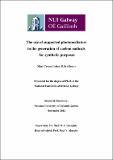| dc.description.abstract | Carbon-carbon bond formation is a key step in synthetic organic chemistry and there are many methods available for carrying it out, a number of which involve the use of carbon radicals. Many methods however involve the use of tin compounds and/or radical initiators such as peroxides or azo compounds and as a result are unattractive. An alternative approach, described in this thesis, involves the photochemical generation of carbon radicals using a photomediator such as an aromatic ketone, for example, benzophenone. While this method is very useful, it is hampered by the need to remove benzophenone, and/or benzpinacol, the result of ketyl radical dimerisation, from the reaction product and this requires column chromatography.
It was in light of these drawbacks that silica supported photomediators were considered for this work. It was anticipated that silica supported photomediators would be easily removed from the reaction by simple filtration. This would not only allow the rapid isolation of products without the need for column chromatography, but would also allow the photomediator to be easily recovered allowing for its possible recycling. It was envisioned that ketyl radical dimerisation might be less of a problem with supported photomediators as recombination should be less efficient for surface bound radicals.
Five supported photomediators were prepared via either covalent or electrostatic bonding of the photomediator to the surface. Carbon-carbon bond forming reactions involving a series of hydrogen donors, 2-propanol, cyclopentanol, 1,3-dioxolane, cyclopentane and THF, and a range of electron deficient unsaturated systems were carried out. The electrostatically bonded photomediators were more efficient than the covalently bonded photomediators. THF was the most reactive hydrogen donor while in general cyclopentane was the most unreactive hydrogen donor. Optimisations studies revealed that the amount of photomediator could be significantly reduced while the recycling studies indicated that the supported photomediators could be recycled a number of times before a decrease in reactivity was observed. A computational model of the silica linked photomediators was developed and used to explore the relationship between the reactivity and structure of the supported photomediators. | en_US |


